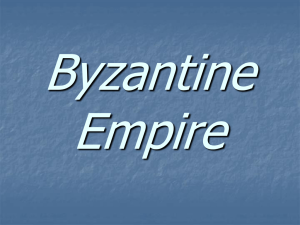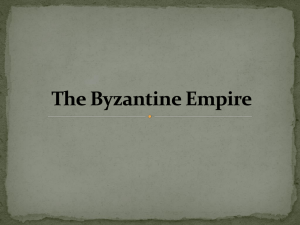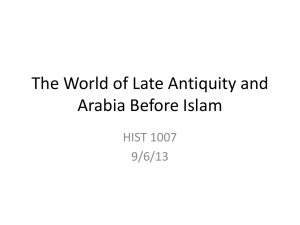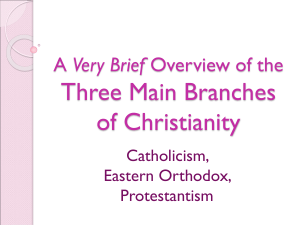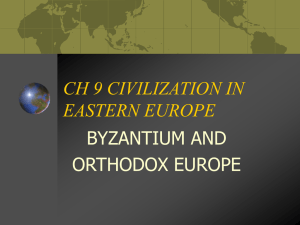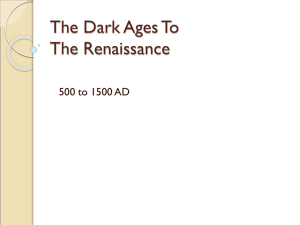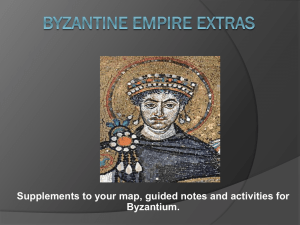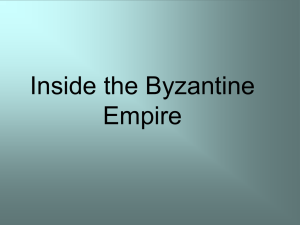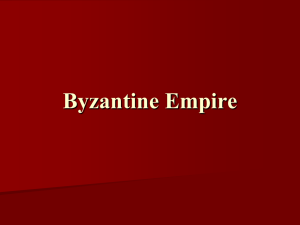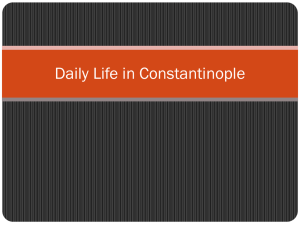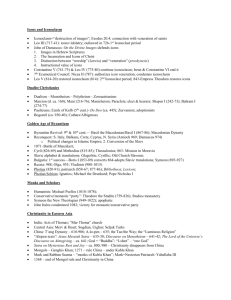Key Terms * The Byzantine Empire
advertisement
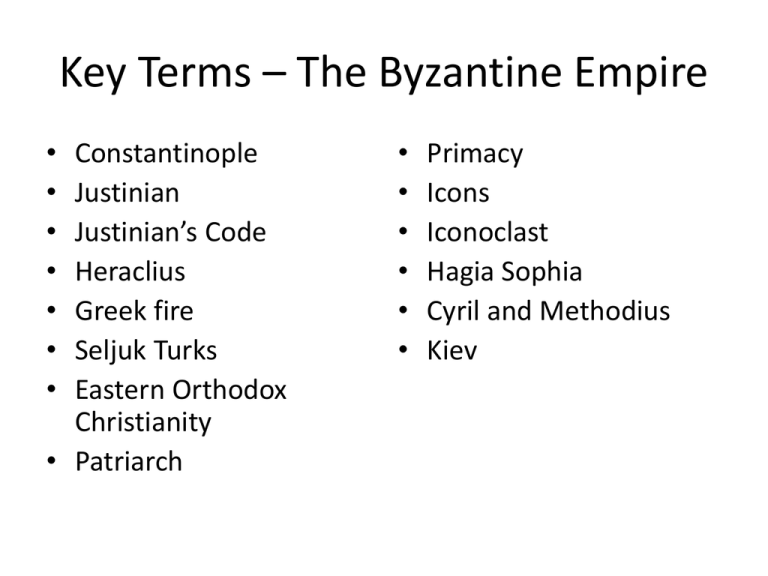
Key Terms – The Byzantine Empire • • • • • • • Constantinople Justinian Justinian’s Code Heraclius Greek fire Seljuk Turks Eastern Orthodox Christianity • Patriarch • • • • • • Primacy Icons Iconoclast Hagia Sophia Cyril and Methodius Kiev Constantinople • Constantinople, in the year 330, became the center of a new empire after the fall of the Western Roman Empire. • The Byzantine Empire was built upon the wealth of Constantinople and control of neighboring territories. • Constantinople provided a good site for control of eastern and western trade Justinian (527-565) • Justinian, upon becoming emperor, had three major goals he sought to accomplish. • These goals would make him one of the best emperors of the Byzantine Empire. • Goals were: – Construct a comprehensive legal code. – Reconquer lost lands – Beatify Constantinople Justinian’s Code • Justinian’s Code comprehensive legal code that incorporated the laws of the roman Empire with those of the Roman Empire. • Was broken into four parts: – The Institutes instruction manual used to read the code – The Digest collection of ideas that could be used to construct new laws. – The Novellae any laws created after 530 A.D. – The Codex Justinian any laws written during the period of the Roman Empire Reconquest of Outer Territories • Justinian would send out one of his best generals, Belisarius to recapture lost territory. • The Byzantines would: – Reacquire Italy, southern Spain – Acquire the Balkans – Acquire Western Asia – Acquire Northern Africa The Hagia Sophia • As a part of Justinian’s beatification project, he asked for the largest church in the world to be built in Constantinople. • The Hagia Sophia would be built also known as the Church of Holy Wisdom, used magnificent structures and a massive dome, would later be converted into a mosque. Heraclius • Heraclius led the Byzantines against invading foreign forces. • Broke the empire into military districts generals were placed in control of each district. • Soldiers who fought to defend the empire were given a grant of land provided extra motivation to defend their territory. Greek Fire • In the 8th century, the Arabs began to use their navy and land army in an attempt to invade Constantinople from two sides. • The Byzantines made use of a new weapon to prevent the advance of the Arabs this invention was known as Greek fire mixture of sulfur, oil, and resin which would be fired from a tube and ignited or placed in pouches and used as molotovs Eastern Orthodox Christianity • Upon the establishment of the Byzantine Empire and the Edict of Milan, a new sect of Christianity was created in the East. • This sect of Christianity was known as the Eastern Orthodox Church. Eastern Orthodox Beliefs • The Eastern Orthodox faith differed from that of Roman Catholicism (western). • Some of these ideas include: – The patriarch as the head of the Eastern Orthodox Church – The lack of icons religious depictions – Masses were said in Greek instead of Latin – Patriarchs were dominated by emperors due to their abolition of the idea of primacy church leaders being above kings. The Great Schism (1054) • A major division occurred within Christianity with the establishment of the Orthodox Church. • As Christians made pilgrimages to Constantinople, many western Christians brought their icons. • Citizens of Constantinople who were Orthodox Christians who did not believe in icons and chose to destroy those icons brought into the city. • These people who broke icons were known as iconoclasts people who break icons. • The pope made decrees stating that icons were allowed anywhere Christians could travel the patriarch would refuse the papal orders and state that the pope held no power in Constantinople – The pope would excommunicate (complete refusal of rites and removal from the church) the patriarch and the patriarch would do the same – This event would set off a major split known as the Great Schism. Cyril and Methodius • The Byzantines sent missionaries to many different areas in an attempt to spread Eastern Orthodox Christianity. • Two monks, Cyril and Methodius would be sent to Kiev the classical capital of Russia. • Considering the people of Russia had no written language, Cyril and Methodius would create one based on the Slavic languages. – The written language would be known as Cyrillic and would become the written language of Russia The Fall of Constantinople • After numerous attempts to enter Constantinople by foreign tribes, the Seljuk Turks would be successful in breaking through. • Seljuk Turks eastern oriented Turks who would take up the mantle left by the Abbassids. • The Seljuk Turks would invade and capture Constantinople in 1453. • Constantinople would become Istanbul and also would become the Turkish capital. So What’s the Big Deal? • The fall of Constantinople had incredible effects on World History. • It led to: – A complete change of perspective in terms of trade with Asia countries in Europe now had to find new ways to arrive in Asia which would lead to the Age of Exploration. – A reliance on a new trading system known as the Hanseatic League which involved north European city-states. – The rise of new empires in Europe as a result of the new strength of the Hanseatic city-states and the Spanish and Portuguese colonial landholdings.
